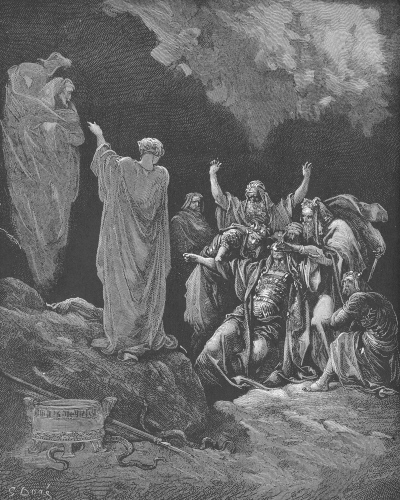Saul and the Witch of Endor is an artwork by Gustave Doré which was part of a series of illustrations that he produced for a publication of The Bible. The tale refers directly to 1 Samuel 28:7.
The artist would make use of scenes from both the Old and New Testament for this commission, producing 241 wood-engravings in total, though his role was specifically in the initial illustrations. Lead engravers would then be employed to oversee the transition of these drawings into carved woodblocks that could then apply the designs into the final published books. In most cases, the initial illustration would be signed by the artist, with the engraver then later adding their own signature in the opposing bottom corner. This has helped historians to keep track of who was involved alongside Doré, as he employed different engravers on different projects and also partnered with a number of publishers from both London and Paris. The series itself was completed in 1866, with the entire set published alongside the accompanying texts. The success of this publication helped the artist to gain more commissions throughout the following decade.
Saul and the Witch of Endor appears in 1 Samuel 31:5-6 from the Old Testament and Saul would actually feature in several of the illustrations within this book, including The Inhabitants of Jabesh-Gilead Recovering the Bodies of Saul and His Sons, Samuel Blessing Saul and also Saul Attempts the Life of David. Within this dramatic scene, Saul and the Witch of Endor, we find a figure hunched over in front of us, with several figures alongside him. A tall figure to the left signals with his hands, and a cloud appears to the left hand side with a face visible within it. Much of the scene is darkened in order to lead our eyes towards the main content. Drama and emotion were typical of scenes from the Bible and also perfectly suited the Romanticist style that can be found throughout Doré's career, in all of the various mediums in which he worked.
Doré was a true master, able to apply his skills of illustration to almost any challenge. Most of his work with books would be new editions of famous literature, often poetry. The Bible offered something a little different in that regard, but he also took on mythology from time to time as well. There were also occasions where he might tackle the same topic in different mediums, such as engravings, followed by later oil paintings. This would show his imagination and also his understanding of the advantages of each of these different techniques. Painting offered him a variety of colour, where as sculpture brought in the third dimension, for example. Despite his success across the board, he will likely always be most famous for the detailed illustrations that filled a number of books in the 1860s and 1870s, with this version of The Bible being amongst his most memorable.




